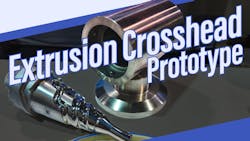Design Engineer Demonstrates Extrusion Crosshead Prototype with Camlock Head
When choosing the right head and die for your extruder in industrial settings, selecting a well-suited connection type—such as a camlock head—is essential to ensure safe, reliable and effective operation.
That is why Jacob Marcure, senior design engineer at Guill Tool & Engineering, showcased a prototype of his latest design at MD&M West 2025.
The crosshead was the second iteration of his design and was going into production soon, according to Marcure, who principally designs parts and is charged with configuring design criteria, such as flow testing and material strength.
READ MORE: Extrusion Takes Some New Turns: Better Design Options in Inline Tubing Dies
“The main idea behind this iteration is, rather than having the typical bolt pattern on the back of the head in order to disassemble it and clean it, this one has a single rotating piece,” said Marcure. “[This feature] not only disconnects the internals from the body, but it also ejects the internals with some mechanical advantage to facilitate the removal process and the cleaning process.”
The crosshead was designed with the wire and cable industry in mind, which is just one vertical market that Guill Tool services. Guill Tool manufacturers extrusion dies for jackets, wire and cable, medical tubing, pipe irrigation and profiles. “We are a fully integrated design and manufacturing house, said Marcure. “We design the parts, we manufacture the parts and we ship the parts out from our warehouse complete.”
For this extrusion crosshead, the pressure range would need to be upwards of 5,000 PSI, Marcure said. The design takes into account the long runs required to meet production quotas. “This industry needs as short a downtime as possible,” he said.
Since short downtime is beneficial for any industry, Guill Tool will be applying the same design features across its crosshead product series, wherever it makes sense.
Designing Crossheads with Purpose
Guill Tool’s design engineers started their design by defining the problem they wanted to solve. That was, “How do we lock this into the head without using any bolts?”
Marcure took cues from other industries. “Mainly this was based on the way that firehose connectors go together,” he said. “We looked at how we could make that a bit more robust to be able to handle the pressures that are generated in an extrusion head.”
READ MORE: High-Risk, High-Reward: Investing in Game-Changing Plastics Extrusion Technology
Firehoses generally will generate somewhere between 100 PSI-200 PSI, he said, but Marcure’s design team would be looking at pressures upwards of 5,000 PSI. Other products included the West Warwick, R.I. manufacturer’s repertoire are extrusion tooling for automotive hose & tube, industrial hose & tube, pipe, blow molding, blown film, food, packaging, pelletizing, rubber & silicone, wire & cable, and wood composite.
In contrast to firehose connectors, Marcure said the design needed to be much more robust, the materials had to be stronger and the design had to be thorough in order to add the margin of safety that is required in industrial applications. Moreover, it needed to be compatible with the industries that Guill Tool serves. “It’s mainly for wire and cable, but the tooling that fits inside is the same tooling that fits into every other one of our heads,” Marcure said.
How Effective is Finite Element Modeling for Crosshead Design?
Marcure employed finite element analysis for strength testing, to ensure that the heat treatment was appropriate and to evaluate the suitability of the materials used.
Once they had the initial concept, the design engineers needed to test that the material and geometry of the design was strong enough to handle the pressure it would be subjected to. They relied on simulation tools, namely, SolidWorks 3D CAD, for the design. In addition, said Marcure, SolidWorks has a plug-in for finite element analysis, which was used for testing the materials. Marcure said his team focused on testing the lugs because these elements not only hold back the force but are also located inside the head.
The crosshead was initially designed with quarter-inch dial pins inside the body. However, through FEA they found that those would shear off at the pressures that they needed to apply in real-world applications and increased to 3/8-in style pins.
Marcure said that finite element analysis is useful and practical for the design and necessary in most cases, but it does not show everything. “One thing that we didn’t catch with the finite element analysis was that while the 3/8-in dowel pins are strong enough to resist shearing apart, a press fit hole in the body isn’t strong enough to withstand the cycle wear from loading and unloading the mating part into the head,” he explained.
Eventually the pins loosened up and didn’t do the job of sealing anymore. “So, there isn’t a drawback to finite element, but it won’t do everything,” Marcure said. “There is still a portion of practical experimental data that you need to get. It is a good starting point and it’s something that we use quite often when there’s any question of material durability or design safety factors that we need to take into account.”
Making Adjustments and Perfecting the Design
Using dowel pins didn’t provide the strength needed for longevity. The next model, Marcure said, will have machined lugs on the inside, similar to the machine lugs inside the mating piece.
The initial version of the head was a fixed center, which meant that there was no adjustment for the concentricity for the tooling, said Marcure. Concentricity is a measure of how well centered the outer diameter of the component is to its inner diameter. In this case, it was simply fixed, fine concentricity between the two pieces, he explained. The engineers opted to have concentricity adjustment installed in the next version, as it factors into the longevity of the head.
READ MORE: A Short Guide to Fatigue Failure in Machine Design
“If there’s anywhere in the components that might imbalance the flow, you can counteract that with the concentricity adjustment, which gives you much more life out of the tooling,” said Marcure. “From start to finish, this was engineered for what we would want to use in the field if we need quick changeovers, longevity and just good practical usability.”
The prototype Marcure brought to the trade show is latest iteration of Guill Tool & Engineering’s crosshead designs. “It is currently going through our production shop,” Marcure said, who also oversees some of the company’s manufacturing, assembly and quality control processes before it ships out.
Editor’s note: For more show coverage, be sure to check out our MD&M West 2025 content hub.
About the Author

Rehana Begg
Editor-in-Chief, Machine Design
As Machine Design’s content lead, Rehana Begg is tasked with elevating the voice of the design and multi-disciplinary engineer in the face of digital transformation and engineering innovation. Begg has more than 24 years of editorial experience and has spent the past decade in the trenches of industrial manufacturing, focusing on new technologies, manufacturing innovation and business. Her B2B career has taken her from corporate boardrooms to plant floors and underground mining stopes, covering everything from automation & IIoT, robotics, mechanical design and additive manufacturing to plant operations, maintenance, reliability and continuous improvement. Begg holds an MBA, a Master of Journalism degree, and a BA (Hons.) in Political Science. She is committed to lifelong learning and feeds her passion for innovation in publishing, transparent science and clear communication by attending relevant conferences and seminars/workshops.
Follow Rehana Begg via the following social media handles:
X: @rehanabegg
LinkedIn: @rehanabegg and @MachineDesign
